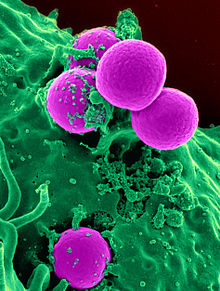Simply put: Wash hands with soapy water or alcohol-based gel. Wipe down all sorts of surfaces frequently—phones, keyboards, etc. Don’t share personal items.
— by Lin McNulty —
The recent news of Council Member Bob Jarman’s outbreak of a Staph A infection, accompanied by an unconfirmed rumor that an islander had recently died from the same infection, caused a curious and concerned Orcas Issues reader to request we look into any public health ramifications.
Known as MRSA (Methicillin-Resistant Staphylococcus aureus) and Necrotizing Fasciitis (flesh-eating disease), although difficult to treat, are the result of bacteria living on the skin of most of us even if we don’t have any symptoms. It is when these infections come into contact with open wounds (large or small) that they enter the body and become systemic.
RN Joanne Runyan, Public Health Nurse with the San Juan County Health Department was most generous in sharing information about these antibiotic-resistant diseases, and provided the following information sheet to inform and reassure us:
What are the symptoms of Staph and MRSA?
Staph and MRSA can cause skin infections that look like pimples, boils, or spider bites. Infected skin can also be red, swollen, painful, and have pus or other drainage. Fever with these symptoms can indicate a more serious infection.
How serious are Staph and MRSA?
Most Staph and MRSA skin infections are minor and easily treated. More serious infections of Staph and MRSA can cause wound infections, bloodstream infections, or pneumonia.
How does a person get Staph or MRSA?
Staph and MRSA are passed most often through skin-to-skin contact with an infected person. It is also possible to get a Staph or MRSA infection from contact with items and surfaces that have been touched by someone who is infected. Staph (including MRSA) can enter the body through cuts or scrapes in the skin.
When is a person with Staph or MRSA contagious?
A person is most contagious when infected wounds are open or have liquid drainage coming from them.
How can I help prevent the spread of Staph or MRSA?
- Wash hands well and often with soap and water – at child care and at home.
- Clean and disinfect surfaces that have come into contact with wound drainage or pus. (A bleach solution, made fresh daily, of 1 tablespoon bleach per 1 quart water may be used to disinfect a surface that has been first cleaned and rinsed.)
- Keep cuts and scrapes clean and dry, and see a health care provider quickly for any possible skin infection.
- Keep all skin infections covered with clean, dry bandages.
- Keep cuts and scrapes clean and covered with clean, dry bandages.
- Do not touch the cuts or bandages of others with bare hands. (Use disposable gloves.)
- Do not share unwashed personal items such as towels, washcloths, sheets, or clothing.
- Wash any clothing, sheets, and towels that have come into contact with infected wounds with detergent and hot water and dry in a hot dryer.
- If your health care provider recommends medicine for an infection, finish all of the medicine even if the infection looks better before then.
- Contact your health care provider if skin infections return, or if more family members get skin infections.
What is the treatment for Staph or MRSA?
Most Staph and MRSA infections are treated by good skin and wound care. A health care provider may drain pus from the infection to help it heal. If an antibiotic is prescribed, it is important to finish all of it.
If my child develops a staph or MRSA infection, must s/he stay away from child care?
- Yes, until s/he has been evaluated by a health care provider and
- any infected skin is completely covered at all times with a clean, dry bandage that prevents access to the wound or wound drainage, and
- the child does not have any other symptoms (such as fever) that would require exclusion from child care, and
- any antibiotics that were prescribed have been taken for at least 24 hours.
One thing to stress is that a wound can be small for the infection to enter the body. Watch out for any redness, pain, swelling, or drainage. An infection may be accompanied by nausea or low-grade fever, but not always.
Spread from one person to another requires direct contact. This is not an airborne bug.
Wash your hands.
**If you are reading theOrcasonian for free, thank your fellow islanders. If you would like to support theOrcasonian CLICK HERE to set your modestly-priced, voluntary subscription. Otherwise, no worries; we’re happy to share with you.**









“Most Staph and MRSA skin infections are minor and easily treated.” Yes, and the key is to pay attention to any cut or open wound, at any age. My brother ultimately died from complications from Staph infection and MRSA, 2 years ago this month. He first contracted it at age 19 via a blister in his toe, which subsequently changed the course of his life. After becoming infected, he was then misdiagnosed as having a rare flu, and by that time it was too late – he was in a coma, and the staph infection had destroyed a heart valve. Learn, and be aware.